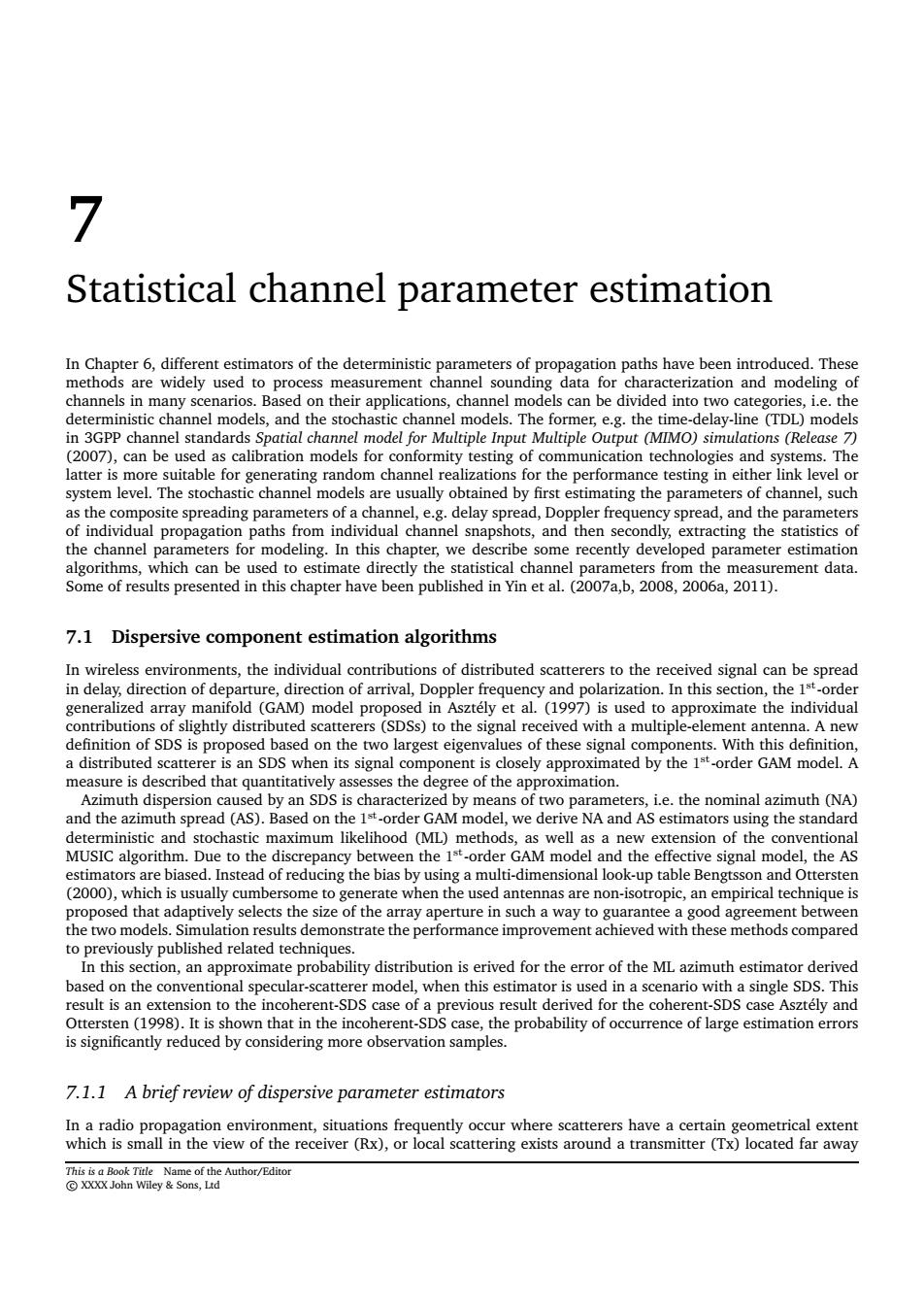正在加载图片...

7 Statistical channel parameter estimation 产 (2007),can be used as calibration models for conformity testing of communication technologies and systems.The 1,e.g.delay ad,Doppler frequen spread,and the parameters al propagation paths fror dualhensnapshosandhenseondlkexrmacingthetaisi eters from the measurement data. 7.1 Dispersive component estimation algorithms In wireless environments.the individual contributions of distributed scatterers to the received signal can be spread direction of departure,direction of arrival,Doppler frequency and polarization.In this section,th genera M)mod 19 definition of SDS is proposedpn its signal component is closely approximated by thesdefinition, adistrib an SD mode that Azimuth dispersion caus d the a thspread (AS J.B ymeans of two parameters,the omnmut(A) we den NA and AS 20omatol whie biased. nstead of reducing the bias byusing amu i-dimensional look-up table Bengtsson and Ot nep呼ea小a dthat adaptively selecs the f the aperure in suchawayto guaranee tte probabtystosivefor theror of the M Ottersten(199).It is shown that in the incoherent-SDS case,the probability of occurrence of large estimation errors is significantly reduced by considering more observation samples 7.1.1 A brief review of dispersive parameter estimators ation envire uently occur where scatterers have a certain otrical exten 7 Statistical channel parameter estimation In Chapter 6, different estimators of the deterministic parameters of propagation paths have been introduced. These methods are widely used to process measurement channel sounding data for characterization and modeling of channels in many scenarios. Based on their applications, channel models can be divided into two categories, i.e. the deterministic channel models, and the stochastic channel models. The former, e.g. the time-delay-line (TDL) models in 3GPP channel standards Spatial channel model for Multiple Input Multiple Output (MIMO) simulations (Release 7) (2007), can be used as calibration models for conformity testing of communication technologies and systems. The latter is more suitable for generating random channel realizations for the performance testing in either link level or system level. The stochastic channel models are usually obtained by first estimating the parameters of channel, such as the composite spreading parameters of a channel, e.g. delay spread, Doppler frequency spread, and the parameters of individual propagation paths from individual channel snapshots, and then secondly, extracting the statistics of the channel parameters for modeling. In this chapter, we describe some recently developed parameter estimation algorithms, which can be used to estimate directly the statistical channel parameters from the measurement data. Some of results presented in this chapter have been published in Yin et al. (2007a,b, 2008, 2006a, 2011). 7.1 Dispersive component estimation algorithms In wireless environments, the individual contributions of distributed scatterers to the received signal can be spread in delay, direction of departure, direction of arrival, Doppler frequency and polarization. In this section, the 1 st-order generalized array manifold (GAM) model proposed in Asztély et al. (1997) is used to approximate the individual contributions of slightly distributed scatterers (SDSs) to the signal received with a multiple-element antenna. A new definition of SDS is proposed based on the two largest eigenvalues of these signal components. With this definition, a distributed scatterer is an SDS when its signal component is closely approximated by the 1 st-order GAM model. A measure is described that quantitatively assesses the degree of the approximation. Azimuth dispersion caused by an SDS is characterized by means of two parameters, i.e. the nominal azimuth (NA) and the azimuth spread (AS). Based on the 1 st-order GAM model, we derive NA and AS estimators using the standard deterministic and stochastic maximum likelihood (ML) methods, as well as a new extension of the conventional MUSIC algorithm. Due to the discrepancy between the 1 st-order GAM model and the effective signal model, the AS estimators are biased. Instead of reducing the bias by using a multi-dimensional look-up table Bengtsson and Ottersten (2000), which is usually cumbersome to generate when the used antennas are non-isotropic, an empirical technique is proposed that adaptively selects the size of the array aperture in such a way to guarantee a good agreement between the two models. Simulation results demonstrate the performance improvement achieved with these methods compared to previously published related techniques. In this section, an approximate probability distribution is erived for the error of the ML azimuth estimator derived based on the conventional specular-scatterer model, when this estimator is used in a scenario with a single SDS. This result is an extension to the incoherent-SDS case of a previous result derived for the coherent-SDS case Asztély and Ottersten (1998). It is shown that in the incoherent-SDS case, the probability of occurrence of large estimation errors is significantly reduced by considering more observation samples. 7.1.1 A brief review of dispersive parameter estimators In a radio propagation environment, situations frequently occur where scatterers have a certain geometrical extent which is small in the view of the receiver (Rx), or local scattering exists around a transmitter (Tx) located far away This is a Book Title Name of the Author/Editor c XXXX John Wiley & Sons, Ltd